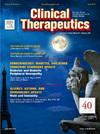雷马唑仑对预防剖宫产术中由卡前列素氨基丁三醇引起的不良反应的效果
IF 3.2
4区 医学
Q2 PHARMACOLOGY & PHARMACY
引用次数: 0
摘要
目的:评估雷马唑仑对预防剖宫产术中卡前列素氨基丁三醇引发不良反应的有效性:方法:选取 2022 年 10 月至 2023 年 7 月期间在我院接受剖宫产手术且有产后出血风险的 200 名产妇作为研究对象。通过随机数字表法将参与者分配到研究组或对照组,每组 100 例。所有产妇均在剖宫产术中接受脊柱和硬膜外联合麻醉(CSEA),然后服用卡前列素氨基丁三醇(250 µg)以预防产后出血。CSEA 用 1.8 至 2 毫升 0.5% 布比卡因和 7 至 10 毫升 2% 利多卡因进行。研究组从 CSEA 开始前 1 分钟开始以 0.3 mg/kg/h 的速度静脉输注瑞马唑仑,最后在手术结束前 20 分钟调整剂量,而对照组则在这段时间内输注相同剂量的生理盐水。主要结果指标为产妇的不良反应和镇静效果:研究结果:恶心和呕吐是两组间唯一存在显著差异的不良反应。研究组报告的恶心和呕吐病例(32 例)明显少于对照组的 48 例。此外,与对照组相比,研究组的 III 级事件发生率明显降低,而 I 级事件风险较高(P < 0.05),这表明使用雷马唑仑似乎减轻了恶心和呕吐的严重程度。比较了新生儿出生时和出生后 5 分钟的阿普加评分,未发现统计学上的显著差异(P > 0.05)。与对照组相比,接受雷马唑仑治疗的产妇镇静效果更好,对治疗的满意度更高(P < 0.05)。两组产妇产后2小时和12小时的出血量以及产后出血持续时间无明显差异(P > 0.05):意义:在 CSEA 下进行剖宫产术时,静脉注射雷马唑仑可有效预防卡前列素氨基丁三醇引起的不良反应,从而改善镇静效果。本文章由计算机程序翻译,如有差异,请以英文原文为准。
Effectiveness of Remimazolam on Preventing Adverse Reactions Caused by Carboprost Tromethamine During Cesarean Section
Purpose
To evaluate the effectiveness of remimazolam in preventing adverse reactions triggered by carboprost tromethamine during cesarean section procedures.
Methods
A total of 200 parturients scheduled for cesarean sections at risk of postpartum hemorrhage in our hospital from October 2022 to July 2023 were included. The participants were assigned via random number table method to either a study group or a control group, resulting in 100 cases in each. All parturients received combined spinal and epidural anesthesia (CSEA) during cesarean section, followed by administration of carboprost tromethamine (250 µg) for preventing postpartum hemorrhage after childbirth. CSEA was performed with 1.8 to 2 mL of 0.5% bupivacaine and 7 to 10 mL of 2% lidocaine. The study group was given remimazolam via intravenous infusion at a rate of 0.3 mg/kg/h commencing at 1 minute prior to CSEA and concluding with a final dosage adjustment 20 minutes preceding the end of surgery, while the control group was given the same volume of saline within this time frame. Primary outcome measures were adverse reactions and sedative effects of the parturients.
Findings
Nausea and vomiting were the only adverse reactions that exhibited significant differences between groups. The study group reported significantly fewer cases (32 cases) of nausea and vomiting when compared to the 48 cases observed in the control group. Moreover, the use of remimazolam appeared to alleviate the severity of nausea and vomiting, as evidenced by the significantly lower incidence of Grade III event and the higher risk of Grade I event in comparison with the control group (P < 0.05). The Apgar scores of newborns at birth and 5 minutes after birth were compared, and no statistically significant difference was found (P > 0.05). Parturients receiving remimazolam exhibited better effective sedation outcomes and were more satisfied with the treatment when compared with controls (P < 0.05). There were no significant differences in postpartum bleeding volume at 2 and 12 hours postpartum, as well as in the duration of postpartum bleeding between the two groups (P > 0.05).
Implications
Intravenous administration of remimazolam effectively prevents adverse reactions induced by carboprost tromethamine during cesarean section performed under CSEA, thereby improving sedative effects.
求助全文
通过发布文献求助,成功后即可免费获取论文全文。
去求助
来源期刊

Clinical therapeutics
医学-药学
CiteScore
6.00
自引率
3.10%
发文量
154
审稿时长
9 weeks
期刊介绍:
Clinical Therapeutics provides peer-reviewed, rapid publication of recent developments in drug and other therapies as well as in diagnostics, pharmacoeconomics, health policy, treatment outcomes, and innovations in drug and biologics research. In addition Clinical Therapeutics features updates on specific topics collated by expert Topic Editors. Clinical Therapeutics is read by a large international audience of scientists and clinicians in a variety of research, academic, and clinical practice settings. Articles are indexed by all major biomedical abstracting databases.
 求助内容:
求助内容: 应助结果提醒方式:
应助结果提醒方式:


